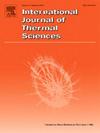The evaluation and development of correlation for heat transfer and fluid flow characteristics in solar air heaters using gapped transverse wire ribs-An experimental study
IF 4.9
2区 工程技术
Q1 ENGINEERING, MECHANICAL
International Journal of Thermal Sciences
Pub Date : 2025-07-19
DOI:10.1016/j.ijthermalsci.2025.110153
引用次数: 0
Abstract
This study investigates the performance of solar air heaters featuring gapped transverse ribs as roughness elements, with the objective of evaluating their heat transfer and fluid flow characteristics. The research explores several operational and geometric parameters, including the Reynolds number (Re), which varies from 2000 to 16000, relative roughness pitch (P/e) ranging from 8 to 10, the number of gaps (Ng) varying from 1 to 4 (in four steps), and relative roughness length (Lg/e) shifting from 18.3 to 84 (in four increments). These parameters are essential to the performance of the 360 mm × 1300 mm test section of the roughened solar air heater. The results indicate that as the Reynolds number (Re) increases, the friction factor (f) exhibits a decreasing trend; however, the Nusselt number (Nu) follows increasing trends. The introduction of gaps in the wire ribs initially enhances the Nusselt number (Nu), reaching a maximum value before declining with a further increase in Ng. The highest recorded Nusselt number of 108.63 was observed at Re = 16000, with P/e = 10, Ng = 2, and Lg/e = 43.3. Similarly, the maximum value of friction factor of 0.03588 achieved at P/e = 8, Ng = 2, Lg/e = 43.3 and Re = 2000. Furthermore, predictive correlations for Nu and f have been established, displaying average percentage mean deviations of 13.01 % for Nu and 8.82 % for f when juxtaposed with experimental values calculated through the proposed equations. A comprehensive comparison with previously published literature has also been undertaken to validate the findings, emphasizing their applicability and reliability within the domains of solar energy, space heating, and agricultural crop drying.
采用间隙横丝肋的太阳能空气加热器传热与流体流动特性相关性的评价与发展——实验研究
本文研究了以间隙横肋为粗糙度单元的太阳能空气加热器的传热和流体流动特性。该研究探讨了几个操作和几何参数,包括雷诺数(Re),范围从2000到16000,相对粗糙度螺距(P/e)范围从8到10,间隙数(Ng)范围从1到4(分四个步骤),相对粗糙度长度(Lg/e)范围从18.3到84(分四个增量)。这些参数对粗化太阳能空气加热器360 mm × 1300 mm试验段的性能至关重要。结果表明:随着雷诺数Re的增大,摩擦因数f呈减小趋势;然而,努塞尔数(Nu)有增加的趋势。在钢丝肋中引入间隙,首先提高了努塞尔数(Nu),达到最大值,然后随着Ng的进一步增加而下降。Nusselt数在Re = 16000处最高,为108.63,P/e = 10, Ng = 2, Lg/e = 43.3。同样,在P/e = 8、Ng = 2、Lg/e = 43.3、Re = 2000时,摩擦系数最大值为0.03588。此外,Nu和f的预测相关性已经建立,当与通过所提出的方程计算的实验值并置时,Nu和f的平均百分比平均偏差分别为13.01%和8.82%。还与以前发表的文献进行了全面比较,以验证研究结果,强调其在太阳能、空间加热和农作物干燥领域的适用性和可靠性。
本文章由计算机程序翻译,如有差异,请以英文原文为准。
求助全文
约1分钟内获得全文
求助全文
来源期刊

International Journal of Thermal Sciences
工程技术-工程:机械
CiteScore
8.10
自引率
11.10%
发文量
531
审稿时长
55 days
期刊介绍:
The International Journal of Thermal Sciences is a journal devoted to the publication of fundamental studies on the physics of transfer processes in general, with an emphasis on thermal aspects and also applied research on various processes, energy systems and the environment. Articles are published in English and French, and are subject to peer review.
The fundamental subjects considered within the scope of the journal are:
* Heat and relevant mass transfer at all scales (nano, micro and macro) and in all types of material (heterogeneous, composites, biological,...) and fluid flow
* Forced, natural or mixed convection in reactive or non-reactive media
* Single or multi–phase fluid flow with or without phase change
* Near–and far–field radiative heat transfer
* Combined modes of heat transfer in complex systems (for example, plasmas, biological, geological,...)
* Multiscale modelling
The applied research topics include:
* Heat exchangers, heat pipes, cooling processes
* Transport phenomena taking place in industrial processes (chemical, food and agricultural, metallurgical, space and aeronautical, automobile industries)
* Nano–and micro–technology for energy, space, biosystems and devices
* Heat transport analysis in advanced systems
* Impact of energy–related processes on environment, and emerging energy systems
The study of thermophysical properties of materials and fluids, thermal measurement techniques, inverse methods, and the developments of experimental methods are within the scope of the International Journal of Thermal Sciences which also covers the modelling, and numerical methods applied to thermal transfer.
 求助内容:
求助内容: 应助结果提醒方式:
应助结果提醒方式:


